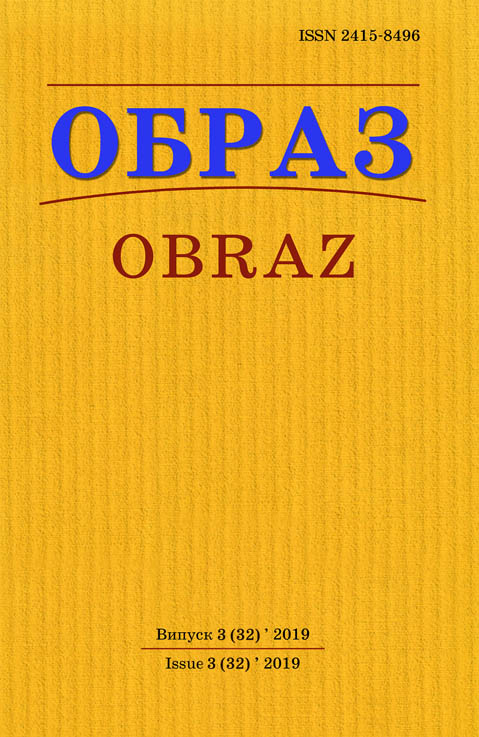Abstract
Purpose of the paper: to analyze, with «Letters from the Khutor (Farm, small village)» as the study material, the methods of communication with the reader, author strategies of addressing the recipient, drawing his attention, the technologies of «furthering an idea» and creating an atmosphere of trust and understanding. Also analyzed are their advantages, disadvantages and shortcomings. Methods. Observation, analysis and generalization, as well as literary concepts of receptive aesthetics, structuralism, post-structuralism and mythological criticism enabled us to identify the fictional author of the letters and the Exemplary Reader (recipient) of the literary work in question. We were also able to define interaction strategies between the writer and the reader. Results and conclusions. In his «Letters» P. Kulish offers the reader a postmodern literary game, in the process of which the Exemplary Reader has to decipher certain meanings and allusions. Particularly, the writer creates the image of a fictional author of the text. It’s an idealized image of a khutor-owning Cossack (free, educated and wealthy). Another persona the fictional writer adopts is the image of the Apostle Paul, who bestows certain significance (even sacredness) unto the text, making it into a spiritual message. In communication with the reader P. Kulish uses the technology of text fragmentation, repetition, addressing the reader directly, intimation and burlesque sentimentalist stylization of the narrative. Such stylization and demonstrative moralizing are considered to be communication shortcomings.
References
1. Apostol narodiv [The apostol of the nations]. – available at: http://hram.in.ua/biblioteka/ apolohetyka/93-book93/885-title988 (accessed : 25.10.2019).
2. Bulashev G. (1993) Ukrayinskyj narod u svoyih legendah, religijnyh poglyadah ta viruvannyah [The Ukrainian people in their legends, religious views and beliefs]. – Dovira, Kyiv, Ukraine. – P.145–163.
3. Vyelcheva K. «Vydinnya pro Petra Oracha» Vilyama Lenglenda: poetyka zhanru [William Langland’s Vision on Peter the Plowman: The Poetics of the Genre] – available at: http:// chtyvo.org.ua/authors/Vielchieva_Kseniia/Vydinnia_pro_Petra_Oracha_Viliama_Lenhlenda_ poetyka_zhanru/ (accessed: 26.09.2019).
4. Vyrskyj D.S. Govtva, bytva 1638 [Govtva, battle 1638] // Encyklopediya istoriyi Ukrayiny: T. 2: G-D / Redkol.: V. A. Smolij (golova) ta in. NAN Ukrayiny`. Instytut istoriyi Ukrayiny. – K.: V-vo «Naukova dumka», 2004. – 688 s.: il. – available at: http://www.history.org. ua/?termin=Govtva_bytva_1638 (accessed: 30.09.2019).
5. Gejzinga J. (1994) Homo Ludens / Per. z angl. O.Mokrovolskogo. – Osnovy, Kyiv. – 250 p.
6. 12 lypnya: Den apostoliv Petra i Pavla, tradyciyi, zaborony ta pochatok pidgotovky do oseni [Jully 12. Peter and Paul Apostles Day, Traditions, Prohibitions and Preparation for Fall] – available at: http://vsviti.com.ua/ukraine/100307 (accessed 12.09.2019).
7. Derrida Zh.(1996) Struktura, znak i gra v dyskursi gumanitarnyh nauk // Slovo. Znak. Dyskurs : Antologiya svitovoyi literaturno-krytychnoyi dumky XX st. (za redakciyeyu M.Zubryczkoyi) [Struktura, sign and game in the discource humanities / /Word. Sign. Discource: Anthology of World Literary and Critical Thought of XX Century]– Litopys, Lviv. – P.457– 478.
8. Eko U. (1996) Poetyka vidkrytogo tvoru // Slovo. Znak. Dyskurs. Antologiya svitovoyi literaturno-krytychnoyi dumky XX st. (za redakciyeyu M.Zubryczkoyi) [Poetics of open Creation // Word. Sign. Discource: Anthology of World Literary and Critical Thought of XX Century]– Litopys, Lviv . –P.406-420.
9. Eko U. (2004) Rol` chytacha: Doslidzhennya z semiotyky tekstiv / Per. z angl. M.Girnyak. [The Role of the Reader : Studies in Semiotics of Texts]–Litopys, Lviv. – P. 21–137.
10. Zhulynskyj M. (1990) Pantelejmon Kulish // Zhulynskyj M. Iz zabuttya – v bezsmertya (Storinky pryzabutoyi spadshhyny) [From oblivion – to immortality (Pages of Forgotten heritage)]. – Dnipro, Kyiv. – P. 43–81.
11. Zubryczka M. (2004) Homo legens: chytannya yak sociokulturnyj fenomen. [Homo legens: reading as a sociocultural phenomenon] – Litopys, Lviv. – 352 p.
12. Kara-Murza S. Manypulyacyya soznanyem [Manipulation of consciousness] – available at: http://www.fhotm.kpi.ua/guest/manipul.pdf. (accessed 9.09.19).
13. Kozachuk G.O. «Oj try shlyahy shyrokiyi do kupy zijshlysya» [«Oh three ways wide to the accumulation came together»] – available at: http://enpuir.npu.edu.ua/ bitstream/123456789/22319/1/Kozachuk.pdf. (accessed 20.09.19).
14. Kulish P. (1989) Lysty z Hutora // Kulish P. Tvory: V 2 t. [Kulish P. Letters from the farm (small village) // Kulish P. Writings: In 2 vols. ]– Dnipro, Kyiv. – V.2. – p. 244–280.
15. Kulish P. (1910) Lysty z Hutora // Tvory Pantelejmona Kulisha, tom shestyj, Vydanye tovarystva «Prosvita» u Lvovi, 1910. – Elektronna biblioteka «Kultura Ukrayiny» [Kulish P. Letters from the farm (small village) // Panteleimon Kulish’s Works, Volume 6, Published by Prosvita Society in Lviv. 1910] – available at: http://elib.nlu.org.ua/view.html?id=9967 (accessed 15.10.2019).
16. Kulish P. (1989) Tvory: V 2 t. – Dnipro, Kyiv. – T.1. Poetychni tvory. [Kulish P. : Writings: in 2 vols. Vol.1. Poetry]. – 654 p.
17. Franko I. (1960)«Hutorna poeziya» P. Kulisha // Materialy do vyvchennya istoriyi ukrayinskoyi literatury: v 5 t. – T.3. Literatura drugoyi polovyny XIX st. [P.Kulish’s «Farm Poetry» // Materials for the Study of the History of Ukrainian Literature: 5 vols. –V.3. Literature of the second half of the XIX centure ] – Kyiv, p. 78–87.
18. Shokalo O. Provisnyk Pravdy i Voli: 200-richchya Pantelejmona Kulisha [The Harbinger of Truth and Will: the 200th anniversary of Panteleimon Kulish ] – available at: http://4hvylia.com/ novyny-usim/svoiechasnist-diievoi-istoriosofii-pentelejmona-kulisha-v-tsilisnosti-ukrainskoisvitohliadnoi-tradytsii.html (accessed 5.10.2019).
19. Shherbak V.O. Zhovnynska bytva 1638 // Encyklopediya istoriyi Ukrayiny: T. 3: E-J / Redkol.: V. A. Smolij (golova) ta in. NAN Ukrayiny. Instytut istoriyi Ukrayiny. [The battle of Zhovnin 1638//Encyclopedia of Ukrainian History: Vol.3]- K.: V-vo «Naukova dumka», 2005. – 672 s.: il. – available at: http://www.history.org.ua/?termin=Zhovnynska_bytva_1638 (accessed: 1.10.2019).
20. Yas` O. Kozaczko-getmanska mynuvshyna v recepciyi P. Kulisha (1840-vi – pochatok 1860-x rokiv) // Mezhdunarodnij kulturnij portal «Eksperyment». [Kozatsko-Hetman past in the reception P.Kulish (1840s – early 1860s) //International cultural portal «Eksperiment»]– available at: https://md-eksperiment.org/post/20181125-kozacko-getmanska-minuvshina. (accessed 15.10.2019).
21. Yauss G. R. (1996) Estetychnyj dosvid i literaturna germenevtyka // Slovo. Znak. Dyskurs: Antologiya svitovoyi literaturno-krytychnoyi dumky XX st. (za redakciyeyu M.Zubryczkoyi) [Aesthetics experience and literary hermeneutics // Word. Sign. Discource: Anthology of World Literary and Critical Thought of XX Century]– Litopys, Lviv. – p. 278–308.

This work is licensed under a Creative Commons Attribution 4.0 International License.
